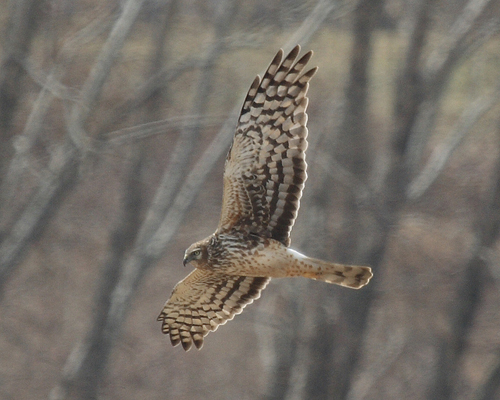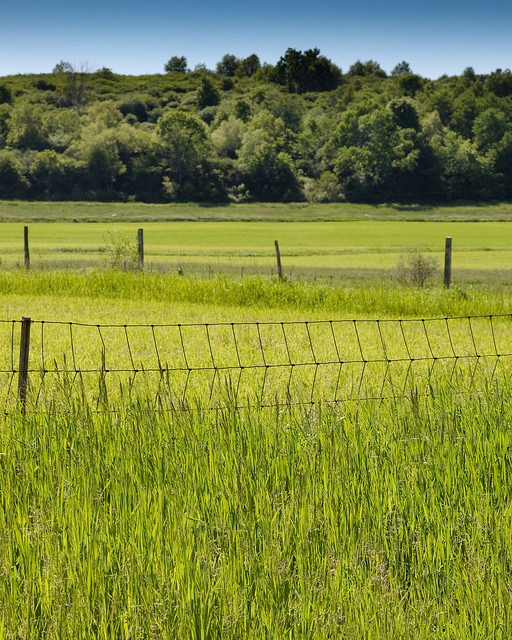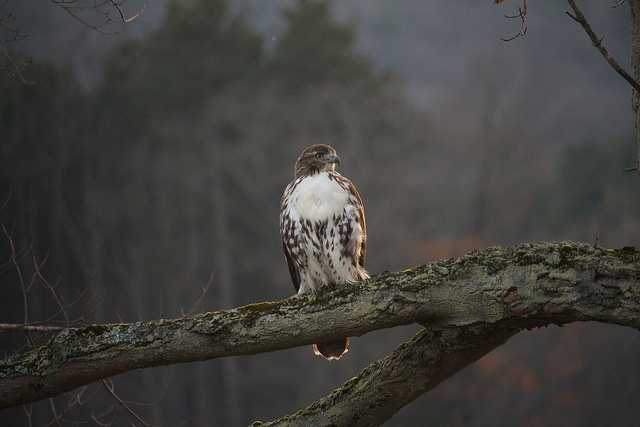On a recent drive across the long stretch of I-86 in southern New York State I started counting. After four hours I counted six. Some were on telephone poles, some on trees and one I witnessed swooping down to, I can only assume, catch a rodent. I was pretty confident all six were Red-tailed Hawks.
Now, when I think back, I can’t recall the specific field marks I used to identify those birds. Did I see the characteristic red tail? Did I spot the distinctive band of darker feathers across the belly? Did the large, stocky body and broad wings give it away? Was is the habitat and time of year? At 65 mph it was none of those things and all those things that led to identification.

Northern Harrier’s distinctive owl like face. Photo by Dave Cooney
As humans we are very good at pattern recognition. We take an input – something we see, hear, smell or touch – and compare what is already in our brain from past experiences. We do this all the time, often without consciously thinking about it. We recognize patterns in faces, language, music, behavior and more. It is not only useful to navigate the world but vital to survive and thrive. It doesn’t seem like a major accomplishment but imagine if everything you experience was new. You wouldn’t be able to recognize a knife as sharp, your cat as something to pet or defend yourself against, or a bar of soap something you wash with or eat.
Recognizing patterns allows us to navigate to work, understand what is safe and what is dangerous – even to read these very words. We also use patterns to identify the plants and animals that we share our world with. Let’s continue with another bird example.
We were eating lunch at the windows at Audubon when someone spotted a bird soaring in the sky. “There’s a Bald Eagle,” someone said. Now a Bald Eagle’s white head and tail and brown body are an easy to recognize pattern. But this bird was far away against a bright sky. Just a dark silhouette. Breaking it down, it was the large size, the way the bird held its wings flat and straight while soaring and its slow wing beats that led us to that identification. All patterns.
We put those patterns into categories based on what they have in common. Even if we haven’t seen a particular species, we can often put it in a group based on certain characteristics it has. A group of hawks called Buteos – of which Red-tailed Hawks are a part – are generally stocky and large, with broad wings and wide, rounded tails. On the other hand, falcons are more streamlined birds with pointed wings and long tails.
So how do great birders do it, identify in a glance all those species? I do not claim that title. I marvel at how others identify a bird that flies by in what seems like half a second or is soaring so that they can’t see any color or markings. They are recognizing patterns created from many, many past experiences. These are most likely outside experiences where attention is paid to the details of color, shape, size, marks and behavior. There are two organizations in this area – Audubon Community Nature Center and The Roger Tory Peterson Institute – who have clear connections to birds through their namesakes. Think about those people. John James Audubon and Roger Tory Peterson were both artists and naturalists, spending a great deal of time outside observing and recording their findings.

Grasslands are a habitat were animals can find food and shelter to rest and reproduce. Photo by Jennifer Schlick.
Identifying birds, or any other natural object doesn’t require you to be an artist. Both men created their artwork to help others recognize patterns in the natural world around them. And there are more resources now – books, video, audio recordings and more. Don’t forget about people who are willing to share their knowledge, too.
There is an opportunity to put those pattern recognition skills to use and share your knowledge or a motivation to learn new patterns in the world around us. The New York State Department of Environmental Conservation (NYS DEC) is asking for help to learn more about imperiled species within the state. They are conducting winter raptor surveys and are particularly interested in Short-eared Owls and Northern Harriers. Both these species are dependent on grassland habitats. These vast stretches of waist-deep grasses are amongst the fastest declining habitat type in the country. As their habitats disappear so to do the species that call them home. In New York State (and Pennsylvania) Short-eared Owls are endangered and Northern Harriers are threatened.
The NYS DEC has enlisted the help of many interested organizations and citizens to provide more eyes on the skies to recognize and document these birds. Of those organizations, the Roger Tory Peterson Institute has assisted in monitoring winter raptor species in Chautauqua County over the past three seasons and is asking for your help this winter. If you are interested in monitoring a nearby field, brushy area near a stream, or marshland in the evenings this winter or participate in coordinated survey efforts contact Elyse Henshaw at the Roger Tory Peterson Institute, ehenshaw@rtpi.org. More information can also be found at www.rtpi.org.
As humans, our brains are built to recognize patterns to identify things to continue learning about the world around us. And when we pool our resources, our understanding of our world is that much greater.
Audubon Community Nature Center builds and nurtures the connections between people and nature. The trails are open for hiking or skiing from dawn to dusk and the Nature Center is open from 1 p.m. – 4:30 p.m. daily except Saturdays when it opens at 10 a.m. Visit auduboncnc.org for more information or call (716) 569-2345.
Katie Finch is a naturalist at ACNC.


Recent Comments